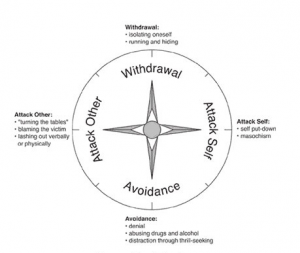I facilitate many large and small group discussions and always find that setting norms or…

Journey Through Shame
I recently attended a conference on Restorative Practices and wanted to share some of my learnings. Something that really stood out for me was the focus on shame and the impact it has on our interactions at work or home.
The Webster Dictionary definition of shame is “a painful emotion caused by consciousness of guilt, shortcoming, or impropriety”. Loader in his 1998 study 1 describes the effect of shame as an inner experience we feel when private aspects of ourselves are unwittingly or unwillingly uncovered. Sounds like vulnerability to me.
Brene Brown a bestselling author and research professor at the University of Houston and has spent the past sixteen years studying the connection between shame and vulnerability. In her 2016 Ted Talk – Listening to Shame, Brene says that shame is an epidemic in our culture. Shame drives two big tapes in our mind: “Never good enough” and “who do you think you are?” Shame grows with secrecy, silence and judgment.
Angel2 in 2005 showed that the understanding of shame provides a critical explanation for why victims of an offence (crime/bullying) often feel a strong sense of shame, even though it was the offender who committed the “shameful” act. Nathanson3 has developed the Compass of Shame (below) to illustrate the various ways that we react when we feel shame. The four poles of the compass of shame and behaviors associated with them are shown here.
The Compass of Shame:
We can use the compass of shame to guide us through our emotions and take a journey through shame. We might be feeling intense emotions and not even recognize that we are really feeling shame. Because shame takes on many different variations, we could be unaware that our actions are symptoms of shame. By outlining and understanding the forms shame takes, we can become more aware of our shame and move through it to more positive emotions.
Brene indicates that empathy is the antidote to shame. Shame isolates and separates, and empathy builds connection, courage and compassion.
Restorative practices such as conferences and circles provide a safe environment for people to express and exchange emotion and foster emotional bonds. They allow participants to reach out to each other, to express shame, to be vulnerable and to show empathy. These processes support the building of awareness and insight and reduce the intensity of emotions. They allow us to walk through our shame and get to the other side where reconciliation and healing are waiting.
- Loader, P. (1998) ‘Such a Shame- A Consideration of Shame and Shamming
Mechanisms in Families’, Child Abuse Review, 7 (1), pp. 44- 57.
- Angel, C. (2005). Crime victims meet their offenders: Testing the impact of restorative justice conferences on victims’ post-traumatic stress symptoms. Ph.D. thesis. University of
Pennsylvania. Retrieved November 7, 2007, from University of Pennsylvania – Electronic Dissertations.
- Adapted from Nathanson, D. L. (1992) Shame & Pride, Affect, Sex & the Birth of the Self, New York, Norton & Company.





